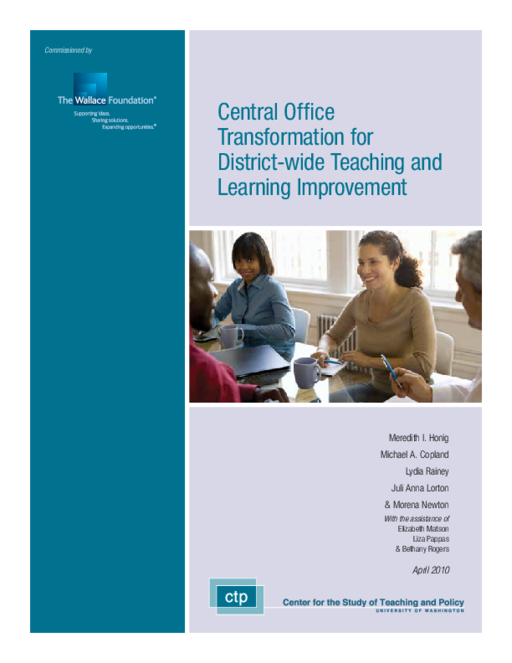Breadcrumb
- Wallace
- Reports
- Central Office Transformation Fo...
Central Office Transformation for District-Wide Teaching and Learning Improvement

Summary
How we did this
Researchers collected data through in-depth interviews with central office administrators, school principals, and representatives from outside organizations involved in the central office transformation effort. They also observed how the central office transformation unfolded in real time as well as reviewed various documents.
This report examines the daily work of central office staff members in three urban districts that shifted their focus from basic services and compliance to improving classroom instruction. The three districts—Atlanta, New York City and Oakland, Calif.—posted student achievement gains that they attributed in part to radically transforming the work of their central office employees.
The study looked inside central offices to understand more specifically what central office administrators were doing as part of their transformation process. The researchers found that their work involves the following five dimensions:
- Learning-focused partnerships with school principals to deepen principals’ instructional leadership practice.
- Assistance to the central office–principal partnerships.
- Reorganizing and reculturing of each central office unit, to support the central office–principal partnerships and teaching and learning improvement.
- Stewardship of the overall central office transformation process
- Use of evidence throughout the central office to support continual improvement of work practices and relationships with schools.
Central office transformation is a far cry from central-office-administration-as-usual. This approach to reform:
- Focuses centrally and meaningfully on teaching and learning improvement
- Engages the entire central office in reform
- Calls on central office administrators to fundamentally remake their work practices and their relationships with schools to support teaching and learning improvements for all schools
- Constitutes an important focus for reform in its own right
This study suggests that district leaders, policymakers, and others interested in districtwide teaching and learning improvement need to move beyond old debates about whether schools or the central office should be driving reform and understand that improving teaching and learning districtwide is a systems problem. They also need to understand that true reform requires changing what people in central office know and can do. It also takes a continuous improvement approach.

Central offices and the people who work in them are not simply part of the background noise in school improvement. Rather, school district central office administrators exercise essential leadership, in partnership with school leaders, to build capacity throughout public educational systems for teaching and learning improvements.
Key Takeaways
- Central offices are not simply part of the background noise in school reform. District-wide improvements in teaching won't happen without leadership from central office staff members working in partnership with schools.
- Restructuring district central offices to better support teaching and learning isn't enough. True reform requires changing what people in central office know and can do.
- Everyone in a district central office—directly or indirectly—must focus efforts on strengthening principals’ instructional leadership in order to improve teaching and learning in schools.

